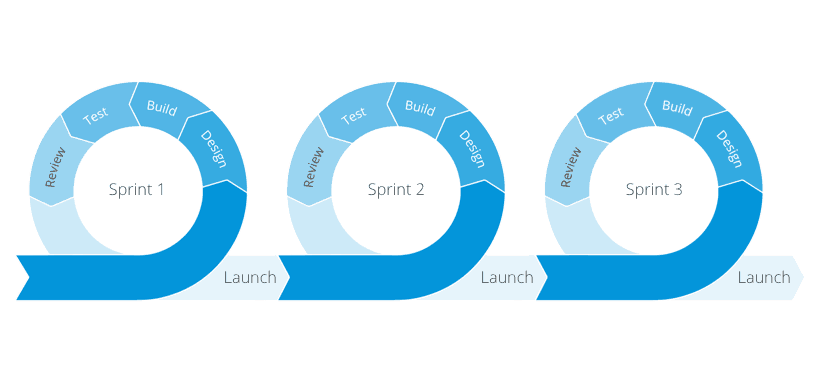Are we agile?
As we grow, we can’t help but seek inspiration from all sources. It’s a good thing to see parallels in the growth of other people on other paths, and wonder: what lessons can I learn? What do we share?
Lately, as Tuesday and I have crossed the threshold of our second year building The Outside, we’ve been thinking about what comes next. We’ve erected the scaffolding of the work and how we do it. We’ve charted the logistics of this endeavour and with every new gig, we practice. We are off and running.
But now that we’re settled — once any new enterprise is off and running — how do we as founders and leaders embody our purpose and principles to the next level?
I sat with my friend Dave in the pub and reflected. He’s founder of Mighty Wee Websites, has a background in software development, and is a great conversationalist as a fellow entrepreneur.
“At this point, what we need is to figure out how to be iteratively rigorous and rigorously iterative,” I said.
“Yeah,” he replied. “That’s agile.”
I felt myself drawing back. Like so many theories and methodologies these days, the word carries a lot of connotations associated with a whole field of practice. It’s not proprietary, codified, or a branded entity. But it’s an approach to software development, not systems change. Agile is its own thing, and it’s not our thing, I thought.
But why not? As a development methodology, ‘agile’ calls for rapid cycles of experimentation and prototyping for rapid, in-practice learning to inform a big project. And that’s a fair description of what we do. We use analysis to inform change, but that’s not enough! We are also guided by local action and rapid cycles of testing to generate data and guide next steps.
But the big distinction: agile has a defined finish line. We do not. In software development, you’re assigned a required outcome. It’s a mechanical kind of creativity. But in the work of shifting human outcomes, nothing is pre-determined (and shouldn’t be). We get requirements, and we set intentions. But we’re never sure, when we begin, what form our action — and our outcome — may take. We learn and navigate as we go. We are as organic as a wanderer in the wilderness, and we like that just fine.
I was curious, though, and Dave offered to send along some further parallels. Here’s what he wrote:
Firstly: don't get hung up on rules or jargon. There is no such thing as an ‘agile’ process. The whole point is to take the bits that work for you and come up with something that fits your needs.
An agile process helps you to map our big projects by classifying chunks of work (and time!) as:
The Roadmap (the work that you have committed to for the next 12 months. Review it all of the time, in line with your SPRINT planning)
Backlog (all the work you know you have, but that may not be connected to the roadmap)
Sprints (a specific period of time where you figure out how many work days you have available, and then you put in stories from the backlog)
We approach the work with a regular format for meetings, depending on the type of work:
Scrum (a daily 15-minute call between everyone in the SPRINT — what did you work on yesterday, what are you working on today, are there any blockers)
SPRINT Planning (a session to update the backlog with estimates, figure out days available in the next SPRINT and add from the backlog, review the roadmap and move things accordingly.)
Close-Outs (At the end of each SPRINT to reflect on how long stories actually took; what we learned; and to make decisions on tasks that are taking longer and will need effort in the next SPRINT)
There’s a huge amount of guidance, apps, and tools online to start thinking of work in the ‘agile’ way, and I loved hearing Dave’s perspective on it as a technician even as my own inner voice protested: But we are not technicians. Human change is not a machine, as much as we may wish it were as easily shifted.
If we know what doesn’t line up, where are the parallels? Tues and I conceived of The Outside as a two-year experiment. We knew we would learn and adjust and learn and adjust as we went, week-by-week and in 18-month increments. We have scrums, sprints, and roadmaps, though we call them by other names. This summer, we’ll take it a step further by allocating hours and days to specific projects and activities, and align that to how many hours and days we each want to work in 2020. We are striving to balance realism and rigorousness with wiggle room and inspiration. We want The Outside to make space for our time as humans — for our lives — and that also makes space for meaningful work.
So far, The Outside has been highly emergent and highly self-organizing, but we need structure for order, and order for growth. Not growth in the interest of capacity alone — ‘do more work’ — but the kind of growth that aligns with our values as partners, parents, friends, and practitioners. After all, if we can’t manage our own change, how can we manage anyone else’s?
Sometimes, an idea can be so heavily-loaded with connotation that it pushes us away. In our enthusiasm to attach to a tribe — as humans do! — we sometimes self-identify out of learning. So take a little, where interesting threads find you. Be a prolific borrower. Riff and play. This is the wilderness! The more maps we’re capable of reading and learning from, the better.




